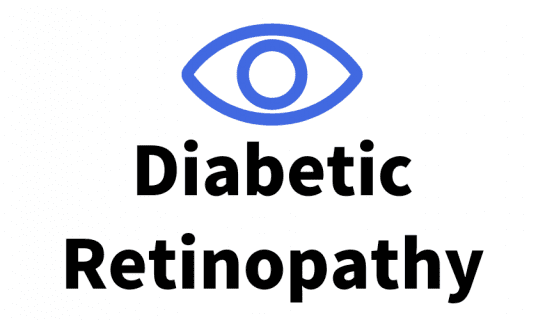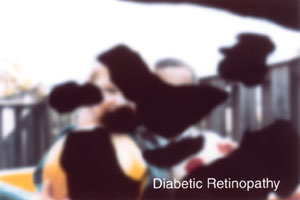Diabetic Retinopathy

What is Diabetic Retinopathy?
Diabetic Eye Disease (DED) refers to a group of eye conditions that are caused by diabetes. The most common of these conditions is Diabetic Retinopathy which will be the primary focus of this section. However there is considerable characteristic overlap between eye conditions in this category. Other conditions include Diabetic Macular Edema, Cataracts and Glaucoma. Diabetes is a condition that affects the body’s ability to produce and use insulin effectively to control glucose levels. Too much glucose in the blood over a prolonged period of time can damage many parts of the body including blood vessels in the eye.
Diabetic Retinopathy (DR) results from high levels of glucose damaging the back of the eye, specifically the Retina. It can cause blindness if left undiagnosed and untreated (usually over several years).
Symptoms of Diabetic Retinopathy
Symptoms can vary drastically. Either or both eyes may be affected across the visual field. Symptoms include:
- Gradually worsening vision
- Sudden vision loss
- Vision floaters (Shapes floating in your field of vision)
- Blurred or patchy vision
- Eye pain or redness
Note that having some of these symptoms doesn’t necessarily mean that a person has DR, but it is advised to not delay in getting your eye(s) examined as soon as possible. Do not wait for your next eye screening test if any of the above symptoms are experienced.

Scene as someone fully sighted would see it.

Scene as someone with Diabetic Retinopathy would see it
How is Diabetic Retinopathy diagnosed
Diabetic eye screening tests involve examinations and taking and analysing photographs of the back of the eye. Diabetes can cause capillaries in the retina to leak a yellow fluid or to bleed which can be picked up on during an eye test. All diabetic patients aged 12+ are offered diabetic eye screening annually as this can help identify DR in its early stages where the person is not yet impacted by symptoms. This can result in early treatments that can help avoid any sight loss and permanent blindness which may occur as a result of late-stage untreated DR. Depending on the results of an eye test, people may be called back for either further tests, more frequent testing or to discuss treatments with a specialist.
Treatments for and management of Diabetic Retinopathy
Treatments vary depending on the stage of development that a person’s DR has reached by the time it has been detected. Specific treatments are prescribed when it has been determined that a person is at risk of sight loss after an eye screening test. If such a risk has not yet been ascertained, then diabetic patients are strongly advised to follow the general guidance on risk and prevention (see the next section of this article). The main treatments for Diabetic Retinopathy are laser treatment, eye injections or an operation (Vitreoretinal Surgery) to remove blood or scarred tissue from your eyes.
Laser treatment can be used to treat the growth of new blood vessels in the retina during later stages of DR. This would be required because these blood vessels are likely to be weak and cause bleeding in the eye. Laser treatment is usually expected to stabilise changes in the eye and prevent further vision loss rather than to improve a person’s sight. The procedure generally takes 20 to 40 minutes. Drops are administered to numb the eyes and widen the pupils. After this, a laser is shone into the eye and focused on the relevant areas of the Retina throughout the procedure. People are usually put under local anaesthetic. Short-term side effects may include blurred vision, increased light sensitivity, aching or discomfort. There are risks of more long-term complications like reduced peripheral and night vision which could impact activities like driving. You can find out more about potential risks and complications by consulting your specialist and at the NHS Diabetic Retinopathy page. These should be discussed and understood before you undertake any procedures.
Depending on the exact type or stage of DR that the person is experiencing, anti-VEGF medicine may be injected into the affected eye(s) to prevent new blood vessels from forming at the back of the eyes. The main types typically used are Lucentis and Eylea. This can prevent eye problems from worsening and may sometimes improve vision. Local anaesthetic drops are administered to numb the eye(s). Sometimes steroid medicine may be given instead of anti-VEGF injections (or if anti-VEGF does not help). Potential side effects of anti-VEGF medicine include eye irritation or discomfort, bleeding inside the eye, floaters or a feeling of having something in the eye, watery or dry, itchy eyes. There is a very low risk of the procedure causing blood clots to form in the eye which could lead to a heart attack or stroke (this should be discussed beforehand). The primary risk with steroid injections is increased pressure inside the eye.
Vitreoretinal surgery may be carried out under general anaesthetic to remove some of the vitreous humour from behind the lens in order to remove any scarred tissue (see above). This is followed by laser treatment to prevent further deterioration in your vision. This operation may be needed if a large amount of blood has gathered in the eye(s) or if there is extensive scarred tissue that has caused or is likely to cause retinal detachment. It may take several months for your vision to properly return. People generally need to wear an eye patch for the first few days post procedure. Activities like reading and watching television are likely to cause strain and tire the eye(s). Consult your surgeon with regard to activities to avoid during recovery as well as potential risks. Some risks include developing cataracts, further eye bleeding, retinal detachment, fluid build up in the cornea, eye infection and a potential need for further retinal surgery.
Prevention and risk factors
Anyone with type 1 or type 2 diabetes is at potential risk of developing DR. Other primary risk factors for developing DR include having had diabetes for a long time, having a persistently high blood glucose level, high blood pressure, high cholesterol, being pregnant and being of Asian or Afro-Caribbean background. As it is usually expected that Diabetic Retinopathy would take several years to reach a stage where sight is threatened, this may be prevented if diabetic patients take care to control blood sugar, blood pressure and cholesterol levels (e.g. through eating a balanced diet, frequent exercise, quitting smoking and to remain firmly committed to any prescribed general medication for diabetes). Sustaining a healthy body weight is also advised. Moreover, various examinations can pick up on the presence of DR prior to major symptoms developing (see above). Diabetic patients should take care to attend all scheduled eye screening appointments to pick up on and treat any potential problems early. For instance, minor (but developing) damage to blood vessels in the eye which have not yet caused sight loss. This is also known as background retinopathy. All diabetic patients should get medical advice promptly and without hesitation upon any changes to their vision.
Further information and Support:
Diabetes UK:
